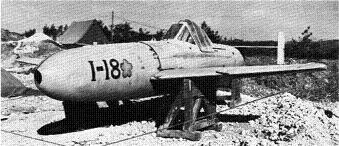![]() The Pacific War Online Encyclopedia
The Pacific War Online Encyclopedia
|
| Previous: Mutsuki Class, Japanese Destroyers | Table of Contents | Next: Myers, Donald J. |

U.S. Navy. Via Francillon (1979)
Yokosuka
MXY7 Ohka Model 11
"Baka"
| Crew | 1 | |||
| Dimensions | 16'10" by 19'11"
by 3'10" 5.13m by 6.07m by 1.17m |
|||
| Wing area | 64.6 square feet 6.0 square meters |
|||
| Weight | 970-4718 lbs 440-2140 kg |
|||
| Maximum level speed | 403 mph at 11,485
feet 649 km/h at 3500 meters |
|||
| Terminal dive speed | 576 mph 927 km/h |
|||
| Power plant | 3 Type 4 Mark 1
Model 20 solid-propellant rockets
with a total thrust of 1764
pounds-force (7841 newtons) |
|||
| Warhead | 2646 lbs 1200 kg |
|||
| Range | 23 miles 37 km |
|||
| Production | A total of 852 Ohkas were built: | |||
| Dai-Ichi Kaigun Koku Gijitsusho, Yokosuka: | ||||
| 155 | Ohka Model 11 | |||
| 50 | Ohka Model 22 | |||
| 45 | Ohka Model K-1 | |||
| 2 | Ohka Model 43 K-1 KAI | |||
| Dai-Ichi Kaigun Kokusho, Kasumigaura: | ||||
| 600 | Ohka Model 11 | |||
| Variants | The
Model 22 had a lighter warhead (551 lbs) and a Tsu-11 turbojet engine,
giving a level speed of only 276 mph at 13,125 feet but extending the
range to 81 miles. The K-1 was a training glider. The K-1 KAI was a two-seat powered trainer. |
|||
Ohka ("Cherry Blossom") was a suicide aircraft designed for kamikaze attack on Allied warships. Most were powered by solid rockets that gave a high speed but very limited range. They were generally carried within range of an enemy task force by a conventional bomber, such as a Betty. The pilot then lit off the rockets and attempted to dive his aircraft into a warship.

U.S. Navy. Via ibiblio.org
Ohka had a rudimentary set of controls and handled unlike any conventional aircraft. This posed a problem for training and may have contributed to the relatively low hit rate of these weapons. American observers reported that many of the Ohkas porpoised during their final run to their targets, suggesting the inexperienced pilots were having difficulty controlling their aircraft. The Japanese tried to solve this problem by developing a glider trainer and, later on, a powered two-seat trainer. Both had retractable landing skids and replaced the warhead with water ballast, which was released before landing to reduce the landing speed to a barely tolerable 138 miles per hour.
The first attempt to launch an attack with the Ohka ended in disaster for the Japanese. On 21 March 1945, a group of 16 Bettys equipped with Ohkas and escorted by two navigator Bettys and about 30 fighters sortied against the American fleet off Okinawa. The
flight encountered poor weather and was ambushed by American fighters a
full 60 miles (95 km) from the American task force. The Bettys could
only make about 160 mph (260 km/h) with their heavy loads, and the
entire bomber force was shot down, along with many of the fighters. The
American pilots noted that the Bettys were flying unusually slowly and
seemed to be carrying an unusual payload, but the significance of these
observations was not understood at once.
The first successful Ohka attacks occured on 1 April 1945, as the Americans were landing on Okinawa, and damaged West Virginia and three transports. That same day, troops occupying Kadena airfield discovered four Ohka in an underground bunker. Judging from Allied damage reports, the warhead of Ohka may have had a delayed fuse appropriate for armor penetration: A number of unarmored warships hit by Ohka escaped severe damage because the warhead did not go off until it had already passed through the ship.
Production was limited by the requirement that the Ohka be
produced entirely at Navy arsenals. Proposals to subcontract some of the
production to private firms were met with objections that this would
violate security, and, more
tellingly, that if the private firms realized what they were producting,
"they would think the navy had gone crazy' (quoted in Grunden 2005).
The Japanese were working on the Model 43A, which was to be launched
from submarines, and the Model
43B, which was to be launched from caves, at the time of the surrender.
There is a sense in which the Ohka was a precursor to the guided
standoff missiles used by naval aircraft today. The chief difference is
that modern missiles use a microprocessor in place of a human suicide
pilot.
References
The Pacific War Online Encyclopedia © 2007, 2011, 2013 by Kent G. Budge. Index